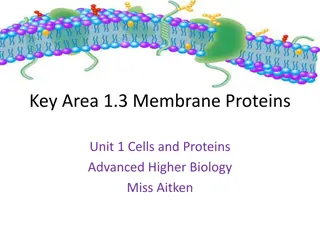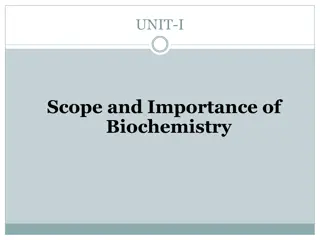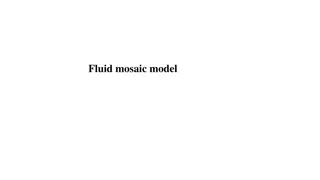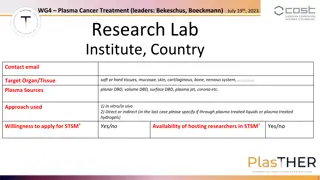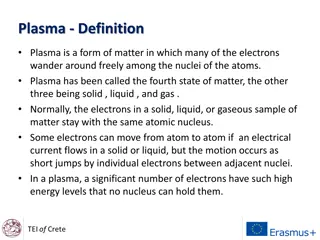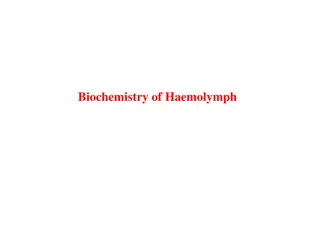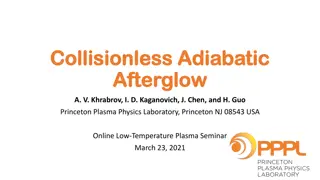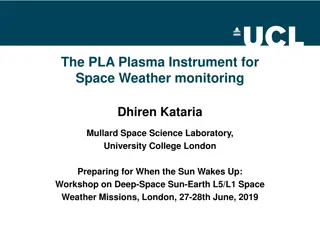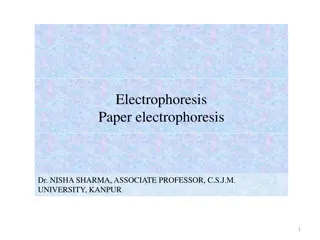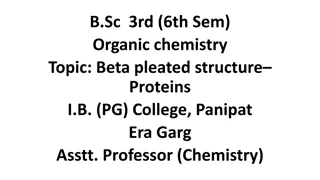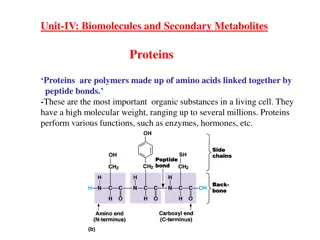Understanding Plasma Proteins in Biochemistry Lectures
This informative content discusses the types, functions, and measurement of plasma proteins in biochemistry. It covers the importance of identifying various plasma proteins, their roles in disease diagnosis, and the interpretation of electrophoretic patterns. The lecture overview provides insights into the significance of over 300 different proteins found in plasma, highlighting their synthesis, functions, and levels in a normal adult. The content also explains the methods of quantitative and semiquantitative measurement of plasma proteins through electrophoresis, emphasizing the significance of understanding protein levels in health and disease.
Download Presentation

Please find below an Image/Link to download the presentation.
The content on the website is provided AS IS for your information and personal use only. It may not be sold, licensed, or shared on other websites without obtaining consent from the author. Download presentation by click this link. If you encounter any issues during the download, it is possible that the publisher has removed the file from their server.
E N D
Presentation Transcript
HbA NH2 H2O2 Cl2O7 KClO3 NAOH CH2O PO4 KMnO4 M E D I C I N E COOH KING SAUD UNIVERSITY Co2 MgCl2 H2O SO2 Doctors slides Doctors notes Important ExtraInformation HCN CCl4 CuCl2 SiCl4 Biochemistry Plasma Proteins Aim for the moon . If you miss, you may hit a star Editing file Editing file
O B J E C T I V E S By the end of this lecture, the Second Year students will be able to: Identify types and various functions of plasma proteins Discuss the role of plasma proteins in the diagnosis of diseases and conditions Identify the role positive and negative acute phase proteins in various diseases Interpret the normal and abnormal electrophoretic patterns of plasma proteins
Plasma Proteins (pps) Plasma contains > 300 different proteins Many pathological conditions affect level of pps Mostly synthesized in the liver Some are produced in other sites Such as: antibodies which are produced in lymphocytes A normal adult contains ~70 g/L of pps
Functions of pps Functions of pps: Maintain plasma oncotic pressure Transport Defense Clotting and fibrinolysis It s the pressure that s caused by protein to pull the water in the blood to the interstitial fluid (Albumin, prealbumin, globulins) (Immunoglobulins and complement) (Thrombin and plasmin) (Albumin)
Semi quantitative is getting an idea of the quantity not an exact number. Ex There is protein X we study its level in a healthy population we come up with a range and then compare it to a person showing symptoms. Measurement of Plasma Proteins Measurement of Plasma Proteins A) Quantitative measurement of a specific protein: B) Semiquantitative measurement by electrophoresis: Electrophoresis: An electrical field is applied to a mixture of proteins to separate it. Separation is based on the size of the molecule. The smallest is the fastest, the heaviest is the slowest. And all of them move to the positive charge. We ll also need a medium for the proteins: gel or paper but usually a gel is used. After separation there a couple of ways to visualize them: by staining them or by binding them to antibodies. Proteins are separated by their electrical charge in electrophoresis immunological reactions: Chemical: Immunological reaction: some proteins we can t design a test sensitive enough to pick up level of the protein; we raise the antibodies against it since they are very specific they increase sensitivity. specific way to measure specific protein. Five separate bands of proteins are observed both ways give the exact amount of wanted to protein. These bands change in disease
Measurement of Plasma Proteins 5 distinct bands with specific positions for each protein and a specific thickness showing the quantity of it. Normal Pattern of Plasma Protein Electrophoresis: Prealbumin is the fastest but it s not shown in the chart so it s albumin. We can call them albumin and the globulins. Intensities are different so we make a density analysis to show the amount of plasma proteins. Albumin 50-55%, gamma 20%, a1 and b 7-14%, A1 is the remaining. Prealbumin is not shown in the classical electrophoresis, we need a more sensitive test (immunoelectrophoresis).
Types of Plasma Proteins Types of Plasma Proteins Prealbumin Albumin 1-Globulins: 2-Globulins: -Globulins: - Globulins Prealbumin is not a precursor of albumin it s a different protein. It s a good indication of nutrition status it has a half life of 2 days not like albumin which is 20 days. a1-Antitrypsin Ceruloplasmin, CRP -fetoprotein haptoglobin transferrin Because of the loss of blood. Also any condition that increases catabolism in the body. 2- microglobulin
Types of Plasma Proteins: 1-Prealbumin (transthyretin): 2-Albumin: A transport protein for: 1. Thyroid hormones 2. Retinol (vitamin A) Migrates faster than albumin in electrophoresis Most abundant plasma protein (~40 g/L) in normal adult Synthesized in the liver as preproalbumin and secreted as albumin Half-life in plasma: 20 days Decreases rapidly in injury, infection and surgery Separated by immunoelectrophoresis Lower levels found in: liver disease, nephrotic syndrome, acute phase inflammatory response, malnutrition Short half-life (2 days)
Functions Functions: It means it attracts water which maintains homeostasis, so for ex. If albumin decreases in blood edema like in nephrotic syndrome. Tissue cells can take up albumin by pinocytosis where it is hydrolyzed to amino acids Maintains oncotic pressure: A non-specific carrier of : Useful in the treatment The osmotic pressure exerted by plasma proteins that pulls water into the circulatory system of liver diseases, hemorrhage, shock and burns hormones, calcium, free fatty acids, drugs, etc. If a person is in shock and needs proteins he goes through pinocytosis where the cell membrane stretches around the molecule and takes it in into a vesicle . because if there s a lot of blood loss or skin burn causing hypovolemia so albumin can maintain oncotic pressure. Maintains plasma volume and fluid distribution in and outside cells 80% of plasma oncotic pressure is maintained by albumin
Hypoalbuminemia Causes: Effects: 1-Edema due to low oncotic pressure: Albumin level drops in liver disease causing low oncotic pressure Fluid moves into the interstitial spaces causing edema 1-Decreased albumin synthesis (liver cirrhosis, malnutrition) 2-Increased losses of albumin: 2-Reduced transport of drugs and other substances in plasma When you take a drug, it goes all around the body by blood and get metabolized and cleared . If protein is less then the time it stays in the body increases. 3-Reduced protein-bound calcium Total plasma calcium level drops Ionized calcium level may remain normal A-Increased catabolism in infections B-Excessive excretion by the kidneys (nephrotic syndrome) No clinical conditions are known that cause the liver to produce large amounts of albumin C-Excessive loss in bowel D-Severe burns (plasma loss in the absence of skin barrier) The only cause of hyperalbuminemia is DEHYDRATION, Another case of low amount of albumin or any other plasma protein is when the nurse wants to draw blood she ll use a tonica to make the veins more visible, so if she forgot to remove it after inserting the needle and she drew blood, albumin amount would be lower than normal because blood flow is occluded.
3- 1-Antitrypsin Types of 1-Antitrypsin Synthesized by the liver and macrophages Over 30 types are known An acute-phase protein that inhibits proteases The most common is M type Genetic deficiency of 1-Antitrypsin Synthesis Antitrypsin occurs in the liver but it cannot secrete the protein 1-Antitrypsin hepatocytes and is deficient in plasma Proteases are produced endogenously and from leukocytes and bacteria Digestive enzymes (trypsin, chymotrypsin) Other proteases (elastase, thrombin) 1- of the defective accumulates in Infection leads to protease release from bacteria and leukocytes Trypsin = protease = digesting protein normally produced by cells in the body. Or proteins that is part of leukocytosis. Antitrypsin is used when proteins are synthesized excessively. Acute phase protein the body s respond is within 24hrs. If increased then its positive if it decreases then its negative.
Clinical Consequences of 1-Antitrypsin Deficiency Neonatal jaundice with evidence of cholestasis Childhood liver cirrhosis Pulmonary emphysema in young adults Laboratory Diagnosis Lack of 1-globulin band in protein electrophoresis 1. Quantitative measurement of 1-Antitrypsin by: Radial immunodiffusion, isoelectric focusing or nephelometry 2. If 1-Antitrypsin is diffient excessive cleavage/digestion of proteins happen. Especially in smokers an inflammatory reaction happens where neutrophils produce elastase, and since there s no 1-Antitrypsin to cleave it, elastase would accumulate causing emphysema
-Fetoprotein (AFP) ABNORMALITIES Synthesizedin the developing embryo and fetus by the parenchymal cells of the liver AFP levels decrease gradually during intra- uterine life and reach adult levels at birth 1. Elevatedmaternal AFP levels are associated with: Neural tube defect (spina bifida), anencephaly Function is unknown but it may protect fetus from immunologic attack by the mother 2. Decreased maternal AFP levels are associated with: Increased risk of Down syndrome No known physiological function in adults 3. AFP is a tumor marker for: Hepatoma and testicular cancer AFP has different isoforms associated to different types of cancers for ex. L3 liver cancer, so we measure L3 isoform AFP and we measure total AFP if L3 is more than 10% then it means that in the next 21 months the person would develop cancer.
Haptoglobin Synthesized by the liver Binds to free hemoglobin to form complexes that are metabolized in the RES Limits iron losses by preventing Hb loss from kidneys Plasma level decreases during hemolysis Prevent hemoglobin loss especially in people w/ hemolytic disease. If hemoglobin went to the kidney first there will be loss of it and it ll cause damage to the kidney and then hemoglobin and iron are lost. Haptoglobin attaches to hemoglobin + iron complex making it bigger and prevent it being transferred to kidney and takes it to be degraded in reticuloendothelial system, after that hemoglobin and iron are taken back in body. RES : Reticulo Endothelial System
Ceruloplasmin Synthesized by the liver Contains >90% of serum copper An oxidoreductase that inactivates ROS causing tissue damage in acute phase response It is called apoceruloplasmin. It carries 90% of copper and the albumin carries the rest 10%. Diffiency causes oxidative damage. Important for iron absorption from the intestine Wilson s disease: Due to low plasma levels of ceruloplasmin Copper is accumulated in the liver and brain
2Microglobulin Transferrin A component of human leukocyte antigen (HLA) Present on the surface of lymphocytes and most nucleated cells Filtered by the renal glomeruli due to its small size but most (>99%) is reabsorbed Elevated serum levels are found in: Overproduction in disease May be a tumor marker for: Leukemia, lymphomas, multiple myeloma A major iron-transport protein in plasma 30% saturated with iron Plasma level drops in: Malnutrition, liver disease, inflammation, malignancy Iron deficiency results in increased hepatic synthesis A negative acute phase protein 1 molecule transferrin binds to 2 molecules of iron Iron liver produces transferrin Elevated serum levels also in : Inflammation , infections , rheumatoid arthritis and SLE Not a tumor marker for diagnosing, rather it helps determining the size of tumor
CRP C-ReactiveProtein (CRP) Binds on the surface of the cells to make them more susceptible to phagocytosis by macrophages An acute-phase protein synthesized by the liver Important for phagocytosis High plasma levels are found in many inflammatory conditions such as rheumatoid arthritis A marker for ischemic heart disease Ultrasensitive c-reactive protein is the marker for ischemic heart disease and not normal CRP
Hypergammaglobulinemia May result from stimulation of: Polyclonal mixture of antibodies from different plasma cells Monoclonal specific type of antibody from one type of plasma protein B cells (Polyclonal hypergammaglobulinemia) Monoclonal proliferation (Paraproteinemia) Polyclonal hypergammaglobulinemia: Stimulation of many clones of B cells produce a wide range of antibodies -globulin band appears large in electophoresis Clinical conditions: acute and chronic infections, autoimmune diseases, chronic liver diseases
Monoclonal Hypergammaglobulinemia Proliferation of a single B-cell clone produces a single type of Ig Appears as a separate dense band (paraprotein or M band) in electrophoresis Paraproteins are characteristic of malignant B-cell proliferation Clinical condition: multiple myeloma A single thin peak thin peak
Positive Acute Phase Proteins Plasma protein levels increase in: *Infection, inflammation , malignancy, trauma, surgery These proteins are called acute phase reactants Mediators cause these proteins to increase after injury Mediators: Cytokines (IL-1, IL-6), tumor necrosis factors and , interferons, platelet activating factor Synthesized due to: body s response to injury Functions: 1. Bind to polysaccharides in bacterial walls 2. Activate complement system 3. Stimulate phagocytosis Examples: 1-Antitypsin, haptoglobin, ceruloplasmin, fibrinogen, c-reactive protein
Positive Acute Phase Proteins Negative Acute Phase Proteins These proteins decrease in inflammation: - Albumin, prealbumin, transferrin Mediated by inflammatory response via cytokines and hormones Synthesis of these proteins decrease to save amino acids for positive acute phase proteins
Plasma proteins summary Types of Plasma Proteins: Prealbumin Albumin 1-Globulins: a1-Antitrypsin, -fetoprotein 2-Globulins: Ceruloplasmin, haptoglobin -Globulins: CRP, transferrin, 2-microglobulin - Globulins Positive Acute Phase Proteins: Plasma protein levels increase in: Infection, inflammation, malignancy, trauma, surgery These proteins are called acute phase reactants Synthesized due to body s response to injury Examples: 1-Antitypsin, haptoglobin, ceruloplasmin, fibrinogen, c-reactive protein Mediators cause these proteins to increase after injury Mediators: Cytokines (IL-1, IL-6), tumor necrosis factors and , interferons, platelet activating factor Functions: 1. Bind to polysaccharides in bacterial walls 2. Activate complement system 3. Stimulate phagocytosis Overview: Functions and characteristics of plasma proteins Measurement of plasma proteins and diagnosis of diseases Electrophoretic patterns of plasma proteins Acute phase proteins Plasma Proteins: Plasma contains >300 different proteins Many pathological conditions affect level of plasma proteins Mostly synthesized in the liver Some are produced in other sites A normal adult contains ~70 g/L of pps Functions of plasma proteins: Transport (Albumin, prealbumin, globulins) Maintain plasma oncotic pressure (Albumin) Defense (Immunoglobulins and complement) Clotting and fibrinolysis (Thrombin and plasmin) Measurement of Plasma Proteins: A) Quantitative measurement of a specific protein: Chemical or immunological reactions B) Semiquantitative measurement by electrophoresis: Proteins are separated by their electrical charge in electrophoresis Five separate bands of proteins are observed These bands change in disease Normal Pattern of Plasma Protein Electrophoresis: Negative Acute Phase Proteins: These proteins decrease in inflammation Mediated by inflammatory response via cytokines and hormones Synthesis of these proteins decrease to save amino acids for positive acute phase proteins Albumin, prealbumin, transferrin
Plasma proteins summary Hypoalbuminemia Albumin Prealbumin (Transthyretin) A transport protein for: Thyroid hormones Retinol (vitamin A) Migrates faster than albumin in electrophoresis Separated by immunoelectrophoresis Lower levels found in: liver disease, nephrotic syndrome, acute phase inflammatory response, malnutrition Short half-life (2 days) Decreased albumin synthesis (liver cirrhosis, malnutrition) Increased losses of albumin Increased catabolism in infections Excessive excretion by the kidneys (nephrotic syndrome) Excessive loss in bowel (bleeding) Severe burns (plasma loss in the absence of skin barrier) Effects: Edema due to low oncotic pressure Albumin level drops in liver disease causing low oncotic pressure Fluid moves into the interstitial spaces causing edema Reduced transport of drugs and other substances in plasma Reduced protein-bound calcium Total plasma calcium level drops Ionized calcium level may remain normal Hyperalbuminemia No clinical conditions are known that cause the liver to produce large amounts of albumin The only cause of hyperalbuminemia is dehydration Most abundant plasma protein (~40 g/L) in normal adult Synthesized in the liver as preproalbumin and secreted as albumin Half-life in plasma: 20 days Decreases rapidly in injury, infection and surgery Functions: Maintains oncotic pressure: The osmotic pressure exerted by plasma proteins that pulls water into the circulatory system Maintains fluid distribution in and outside cells and plasma volume 80% of plasma oncotic pressure is maintained by albumin A non-specific carrier of hormones, calcium, free fatty acids, drugs, etc. Tissue cells can take up albumin by pinocytosis where it is hydrolyzed to amino acids Useful in treatment of liver diseases, hemorrhage, shock and burns.
alpha1 and alpha2 globulins summary 1-Antitrypsin 1-Antitrypsin Ceruloplasmin Synthesized by the liver and macrophages An acute-phase protein that inhibits proteases Proteases are produced endogenously and from leukocytes and bacteria Digestive enzymes (trypsin, chymotrypsin) Other proteases (elastase, thrombin) Infection leads to protease release from bacteria and from leukocytes Over 30 types are known The most common is M type Genetic deficiency of a1-Antitrypsin Synthesis of the defective a1-Antitrypsin occurs in the liver but it cannot secrete the protein 1-Antitrypsin accumulates in hepatocytes and is deficient in plasma Clinical Consequences of a1-Antitrypsin Deficiency Neonatal jaundice with evidence of cholestasis Childhood liver cirrhosis Pulmonary emphysema in young adults Laboratory Diagnosis Lack of 1-globulin band in protein electrophoresis Quantitative measurement of 1-Antitrypsin by: Radial immunodiffusion, isoelectric focusing or nephelometry Synthesized by the liver Contains >90% of serum copper An oxidoreductase that inactivates ROS causing tissue damage in acute phase response Important for iron absorption from the intestine Wilson s disease: Due to low plasma levels of ceruloplasmin Copper is accumulated in the liver and brain -Fetoprotein (AFP) Synthesized in the developing embryo and fetus by the parenchymal cells of the liver AFP levels decrease gradually during intra- uterine life and reach adult levels at birth Function is unknown, but it may protect fetus from immunologic attack by the mother No known physiological function in adults Elevated maternal AFP levels are associated with: Neural tube defect, anencephaly Decreased maternal AFP levels are associated with: Increased risk of Down s syndrome AFP is a tumor marker for: Hepatoma and testicular cancer Haptoglobin Synthesized by the liver Binds to free hemoglobin to form complexes that are metabolized in the RES Limits iron losses by preventing Hb loss from kidneys Plasma level decreases during hemolysis
and Gamma Globulins summary Monoclonal Hypergammaglobulinemia Transferrin C-Reactive Protein (CRP) An acute-phase protein synthesized by the liver Important for phagocytosis High plasma levels are found in many inflammatory conditions such as rheumatoid arthritis A marker for ischemic heart disease A major iron-transport protein in plasma 30% saturated with iron Plasma level drops in: Malnutrition, liver disease, inflammation, malignancy Iron deficiency results in increased hepatic synthesis A negative acute phase protein Proliferation of a single B-cell clone produces a single type of Ig Appears as a separate dense band (paraprotein or M band) in electrophoresis Paraproteins are characteristic of malignant B-cell proliferation Clinical condition: multiple myeloma Hypergammaglobulinemia May result from stimulation of B cells (Polyclonal hypergammaglobulinemia) Monoclonal proliferation (Paraproteinemia) Polyclonal hypergammaglobulinemia: Stimulation of many clones of B cells produce a wide range of antibodies -globulin band appears large in electophoresis Clinical conditions: acute and chronic infections, autoimmune diseases, chronic liver diseases 2 Microglobulin A component of human leukocyte antigen (HLA) Present on the surface of lymphocytes and most nucleated cells Filtered by the renal glomeruli due to its small size but most (>99%) is reabsorbed Elevated serum levels are found in Overproduction in disease May be a tumor marker for: Leukemia, lymphomas, multiple myeloma
QUIZ Q4 : Which ONE of the following is the cell that synthesize alpha-Fetoprotein ? A- parenchymal cells of kidney . B- parenchymal cells of liver . C- lumen cells of kidney . D- lumen cells of liver . Q1: low levels of prealbumin is found in ? A- liver disease B- Arthritis . C- Vitamin A deficiency . D- All of the above Q2 : Which ONE of the following is an effect of hypoalbuminemia ? A- Edema . B- inflammation . C- Increase transport of drugs . D- Plasma Ca Increase . Q5 : What is the function of Haptoglobin ? A- protect against infection . B- prevent HB loss from liver . C- limits iron loss related to kidney . D- Non of the above Q3 : the most common type of alpha1-Antitrypsin is ? A- L . B- N . C- M . D- both A & B . Q6 : Which of the following is true regarding CRP ? A- Important for phagocytosis . B- synthesized by kidney . C- marker for heart failure . D- All of them .
QUIZ Q7 : What are the abnormalities associated with impaired alpha-fetoprotein ? 1- Elevated maternal AFP levels are associated with: Neural tube defect (spina bifida), anencephaly 2- Decreased maternal AFP levels are associated with: Increased risk of Down syndrome 3- AFP is a tumor marker for: Hepatoma and testicular cancer Q8 : Determine two causes and associated conditions of hypoalbuminemia ? 1- Decreased albumin synthesis (liver cirrhosis, malnutrition) 2- Increased losses of albumin Increased catabolism in infections Excessive excretion by the kidneys (nephrotic syndrome) Suggestions and recommendations Suggestions and recommendations 1) A 2) A 3) C 4) B 5) C 6) A
T E A M M E M B E R S TEAM LEADERS Naser abu-dujain Mohammad Almutlaq Rania Alessa Mohannad alzahrani Bushra Kokandi Haifa bin taleb Zaina alkaff
THANK YOU FOR CHECKING OUR WORK Lippincott's Illusrated Reviews Biochemistry 6th E Review the notes PLEASE CONTACT US IF YOU HAVE ANY ISSUE @436Biochemteam Biochemistryteam436@gmail.com





